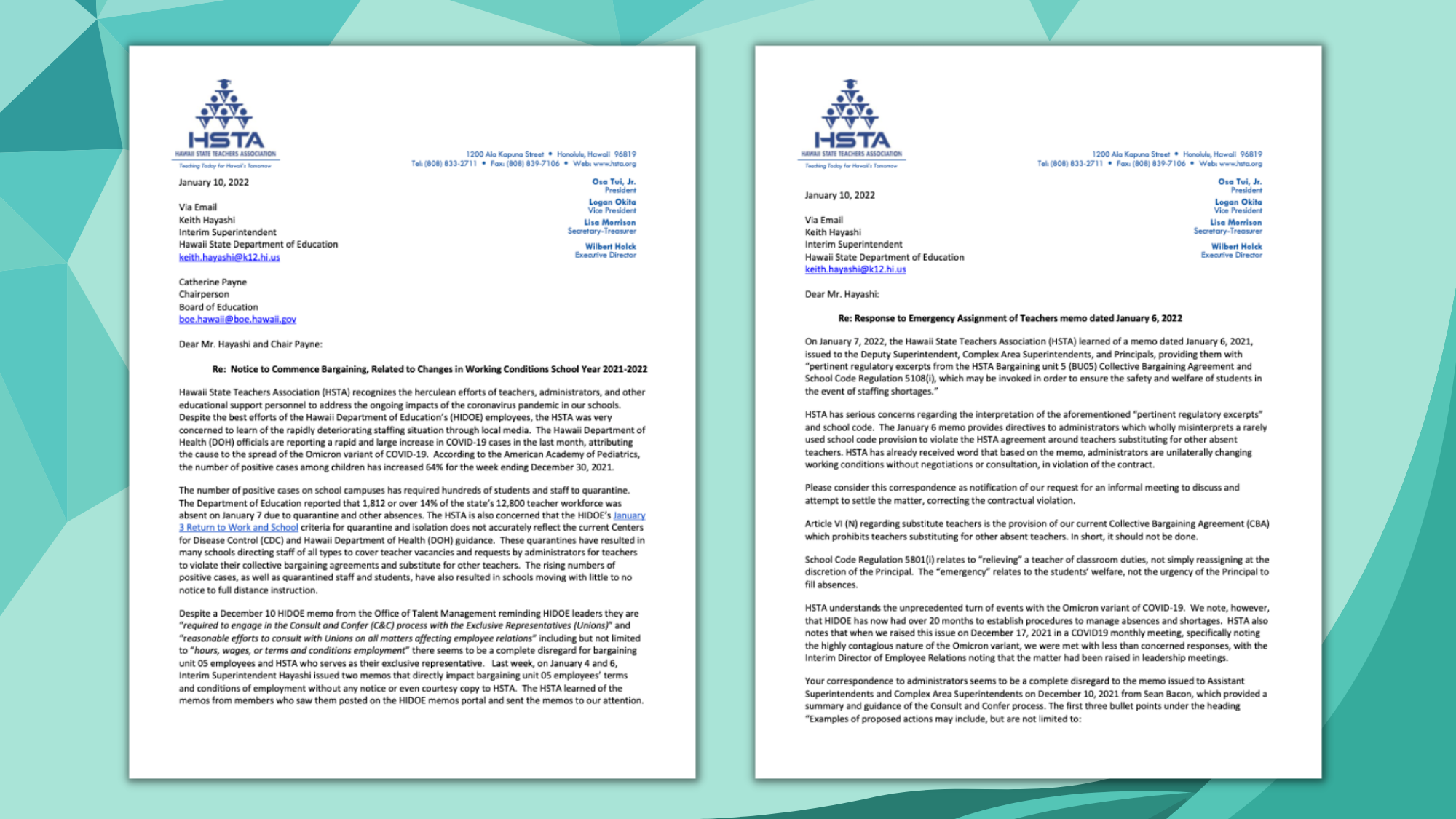HIDOE’s refusal to negotiate resulted in mass confusion, contract violations
Posted: January 12, 2022
This week, the Hawaii State Teachers Association (HSTA) submitted a new demand for impact bargaining to interim Schools Superintendent Keith Hayashi and Hawaii Board of Education Chair Catherine Payne over recent changes by the Hawaii State Department of Education (HIDOE) to members’ working conditions without appropriate negotiation or a consult-and-confer process, which are violations of our contract, HIDOE policy, and state law.
The HSTA also initiated a grievance regarding the interim superintendent’s direction to administrators to inappropriately subvert the HIDOE school code to force non-classroom teachers with their own responsibilities to substitute in violation of our collective bargaining agreement.
Over the last two weeks, schools across the state have been scrambling as the number of positive cases on campuses requires hundreds of students and staff to quarantine. Teachers rightfully ask what they’re supposed to do when a large portion, or even a majority of their class, is not present. Sunset Beach Elementary and Waianae Intermediate have already switched to full-distance instruction with little to no notice or planning, and we hear more schools are trying to do the same and are being denied.
HSTA agrees that schools need flexibility to make the best decision for their students based on staffing shortages and student absences. However, they also need clear, consistent, negotiated guidance that addresses key issues. What thresholds or criteria need to be in place to temporarily move to distance learning? How long should distance learning occur before returning to campus? What should be done about vulnerable populations?
Instead, Hayashi chose to issue a memo on the first day students returned from winter break telling principals to be ready to close classrooms due to staffing or rolling absences. He followed up a few days later with another memo unilaterally authorizing principals to reassign non-classroom teachers to substitute for absent teachers. Without any negotiation, this move violates HSTA’s contract and inappropriately invokes a portion of the HIDOE’s school code, Regulation #5108 (I) outlined here.
Click to view:
- Response to the Impact of the Coronavirus Disease 2019 for the Second Semester of School Year 2021-2022, Jan. 4, 2022
- Emergency Assignment of Teachers, Jan. 6, 2022
- Attachment: Letter to Reassigned Teacher
Why a memorandum of understanding is necessary
At the start of the 2020–21 school year, the HSTA and HIDOE worked out a memorandum of understanding (MOU) to establish clear guidelines to deal with COVID-19’s effects on our classrooms. When that expired on June 30, 2021, the employer refused to consider an extension, and protocols that addressed health and safety, moving to different instructional models, etc. reverted to pre-pandemic practices.
When students are absent, teachers should not be expected to deliver instruction virtually to students who are not on campus, and especially not in a hybrid mode. Teachers are responsible for the students who are on their rosters and report to campus, and need to provide make-up work for those who cannot report to class.
Without a negotiated MOU to allow for different modes of instruction, schools must follow HSTA’s collective bargaining agreement Article X.G, Teacher Protection, which states that “when students are sent home from school or are not required to attend due to emergencies which endanger health or safety, teachers will not be required to remain at, nor report to, said schools.”
A health emergency should not be an excuse for poor management, ineffective leadership, and a lack of good-faith collaboration. HSTA believes ongoing negotiations are vital to maintain strong, consistent educational services for our keiki in light of ever-changing conditions. The department’s refusal to negotiate has forced us to take our case to the Hawaii Labor Relations Board. For months, we have asked the department for a plan that prepares us for the next variant — and we’ve already seen two very different and dangerous variants in the past five months. As we now see, HIDOE and Hayashi’s myopic focus on in-person learning has resulted in mass confusion, contract violations, and dwindling morale in our schools despite the herculean efforts of teachers, administrators, and other educational support personnel.
Additional health and safety measures are needed
The HSTA also believes rapid testing should be readily available at each and every worksite. Teachers should be able to send a symptomatic student to the health room at any point during the school day to get tested to help reduce the spread of the virus. Testing currently remains an issue for many students and staff who cannot easily and quickly access testing and results.
During the winter break, the interim superintendent touted low numbers and minimal spread in our school system. Since then, we’ve seen cases skyrocket, as reflected on the HIDOE COVID-19 case count dashboard. The dashboard is said to reflect “all confirmed and probable cases” for students, staff members, or affiliated individuals connected to your campus who have tested positive for COVID-19 as mandated by law.
Yet this reporting, implemented after our push for transparency, also appears problematic. Clicking on List View at the top of the dashboard reveals that many schools, including some of the largest ones in the state, have not reported any cases for months despite reports from members and parents affiliated with those same schools that they are having daily and weekly updates with positive cases on campus. We encourage you to take a look and see if your school is regularly updating their numbers and question your administrators if they are not.
This chaos could have been minimized if the interim superintendent had shown a willingness at any point during his tenure to collaborate on these critical issues. The HSTA will continue to do everything we can to ensure Hawaii’s public schools are safe and equitable, and support all students.

